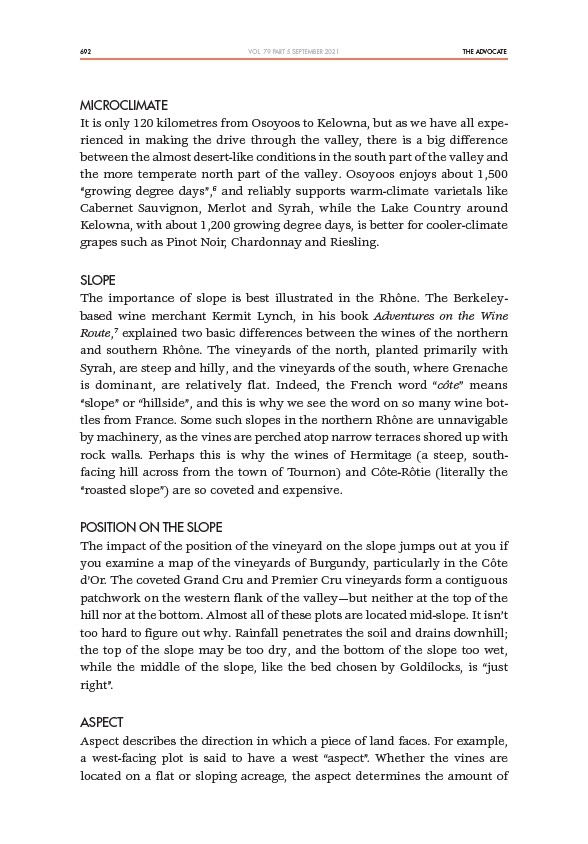
692 THE ADVOCATE
VOL. 79 PART 5 SEPTEMBER 2021
MICROCLIMATE
It is only 120 kilometres from Osoyoos to Kelowna, but as we have all experienced
in making the drive through the valley, there is a big difference
between the almost desert-like conditions in the south part of the valley and
the more temperate north part of the valley. Osoyoos enjoys about 1,500
“growing degree days”,6 and reliably supports warm-climate varietals like
Cabernet Sauvignon, Merlot and Syrah, while the Lake Country around
Kelowna, with about 1,200 growing degree days, is better for cooler-climate
grapes such as Pinot Noir, Chardonnay and Riesling.
SLOPE
The importance of slope is best illustrated in the Rhône. The Berkeleybased
wine merchant Kermit Lynch, in his book Adventures on the Wine
Route,7 explained two basic differences between the wines of the northern
and southern Rhône. The vineyards of the north, planted primarily with
Syrah, are steep and hilly, and the vineyards of the south, where Grenache
is dominant, are relatively flat. Indeed, the French word “côte” means
“slope” or “hillside”, and this is why we see the word on so many wine bottles
from France. Some such slopes in the northern Rhône are unnavigable
by machinery, as the vines are perched atop narrow terraces shored up with
rock walls. Perhaps this is why the wines of Hermitage (a steep, south-
facing hill across from the town of Tournon) and Côte-Rôtie (literally the
“roasted slope”) are so coveted and expensive.
POSITION ON THE SLOPE
The impact of the position of the vineyard on the slope jumps out at you if
you examine a map of the vineyards of Burgundy, particularly in the Côte
d’Or. The coveted Grand Cru and Premier Cru vineyards form a contiguous
patchwork on the western flank of the valley—but neither at the top of the
hill nor at the bottom. Almost all of these plots are located mid-slope. It isn’t
too hard to figure out why. Rainfall penetrates the soil and drains downhill;
the top of the slope may be too dry, and the bottom of the slope too wet,
while the middle of the slope, like the bed chosen by Goldilocks, is “just
right”.
ASPECT
Aspect describes the direction in which a piece of land faces. For example,
a west-facing plot is said to have a west “aspect”. Whether the vines are
located on a flat or sloping acreage, the aspect determines the amount of